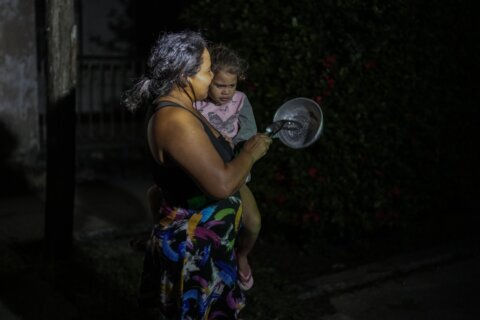Maybe you’ve been outside at a summer barbecue for the day, and you start to notice a red, itchy rash on your skin. While it’s possible that you’ve brushed up against or eaten something you’re allergic to, you might actually be experiencing heat rash. It’s sometimes also called “prickly heat” or “sweat rash,” and it happens when sweat glands become blocked.
While heat rash is common in the summer when the temperature is warm and humidity is high, it’s also possible to get heat rash when you’re exercising hard and sweating in the gym or while you’re in a sauna.
[See: Best Products for Summer Health Hazards]
Heat Rash Types and Symptoms
Heat rash is exactly what it sounds like: It’s a rash brought on by the heat that often looks like small, red pimples in patches on the skin.
“It can happen to anyone in the right circumstances when they are sweating,” says Dr. Tania Elliott, who is dual board-certified in allergy and immunology and internal medicine. She’s a faculty member at NYU Langone health and a spokesperson for the American College of Allergy, Asthma and Immunology.
There are a couple of different types of heat rash, but some are more common than others, including:
— Miliaria crystallina: This mild form of heat rash occurs when pores at the surface of the skin become trapped, and tiny bumps form.
— Miliaria rubra: With small bumps that look like blisters or pimples, this form of heat rash can prickle and itch, leading to the “prickly heat” moniker.
— Miliaria profunda: The inflamed bumps fill with pus deeper in the skin, and they may look more like tough, skin-colored bumps.
Common areas of heat rash
While heat rash can happen anywhere on the body, it’s more often found in skin folds and other areas where heat and sweat gets trapped:
— Where clothing rubs against the skin: Waistbands, straps, ties and other areas where clothing touches skin can trap sweat and cause heat rash.
— In and near skin folds: Areas like the armpits, behind the knees, inside the elbows, the inner thighs and under the breasts trap sweat and heat.
— Neck, shoulders, chest and face: These areas are also more prone to heat rash.
[READ: Autoimmune Skin Disease Treatments.]
Heat Rash Causes
Elliott says that heat rash is caused by blockage or inflammation in the eccrine sweat ducts, which are all over your body, These ducts help with sweat production, which cools you down on a hot summer day. Some of the circumstances that can make it more likely that someone will develop heat rash include:
— Hot and humid environments
— Strenuous physical activity
— Creams or lotions that block sweat ducts, like Vaseline
— Tight-fitting clothing
Anyone, from young kids to adults, can get heat rash. However, some people are more susceptible than others, says Dr. Neera Nathan, a dermatologist and researcher at Massachusetts General Hospital in Boston. In particular, people who are prone to excess sweating, also called hyperhidrosis, are more likely to experience heat rash. In addition, if you have a fever or are hospitalized, you may be more likely to develop heat rash, she says.
Heat Rash Treatment
The good news is that the best ways to reverse heat rash are relatively simple, and generally correspond to doing the opposite of the things that might cause heat rash. For example, Elliot recommends:
— Cooling down by taking a cool shower or finding a building with air conditioning
— Applying ice to affected areas
— Washing off any creams or lotions
— Removing tight-fitting clothing
You can also try a hydrocortisone cream applied to the heat rash area if these cooldown techniques don’t work. This cream is available over-the-counter and is a corticosteroid. It’s used for a variety of skin conditions like poison ivy or sumac, bug bites and eczema (atopic dermatitis). Nathan also recommends itch relief lotions like sarna or calamine lotion to help with symptoms.
What not to do with heat rash
Elliot says that while it might be tempting to try other creams for heat rash, there are some types of creams and ointments that could make heat rash worse.
“Avoid Benadryl cream and Neosporin, which are sensitizers that can trigger allergic reactions if they get underneath the skin barrier,” she recommends.
Additionally, avoid Vaseline or petroleum jelly and other heavy creams like shea butter and oils, which can further block sweat ducts.
If you’ve been outside in the heat for a while and develop heat rash, you’ll also want to be aware of other heat-related health effects. Make sure you’re drinking enough water to stay hydrated through the summer heat, and watch for other signs of heat illness, such as heat stroke.
[READ MORE: Health Questions to Ask Your Doctor]
When to See a Doctor for Heat Rash
If you think you’re experiencing heat rash, first follow the tips to treat heat rash. Unless you’re also experiencing additional symptoms, like those of heat stroke, heat rash can usually be treated and will go away on its own.
“This rash usually goes away on its own. If you have a prolonged fever or a rash that persists longer than a few days, I recommend seeing a doctor,” says Nathan.
If you’re also experiencing symptoms of heat stroke, like slurred speech, loss of consciousness, having a body temperature over 104 degrees F or having hot, dry skin, call 911 immediately.
How to Prevent Heat Rash
While there’s no surefire way to prevent heat rash, there are a few things you can do to reduce your risk:
— Avoid steam rooms. You don’t have to be outside to get heat rash. The sauna or steam room at the gym or spa can cause heat rash as well.
— Choose loose-fitting cotton clothing. A breezy, cotton skirt or an oversized cotton T-shirt can make heat rash symptoms more comfortable. Sweaty clothing waistbands and straps can cause heat rash and chafing, which can be painful.
— Stay in cool, dry locations when possible. Even if just for a little while, it can be helpful to break up your heat exposure with periods of time spent in air conditioning.
— Wash off heavy creams and ointments before going outside in the heat. Dry-touch sunscreens with a lighter feeling can be better for avoiding heat rash. Wash off any shea butter, body lotion or petroleum jelly before spending time in the heat.
Other Conditions Commonly Mistaken for Heat Rash
Heat rash is relatively common, but it’s possible that what you think is heat rash is actually something different. For example, a similar rash could be due to:
— Hives, which can be caused by an environmental or food allergy
— Medication allergies, which can include allergies to antibiotics, ibuprofen, aleve and more
— Folliculitis, or inflammation of the follicles on your skin that has various causes, including bacteria, ingrown hairs, fungi and friction
— Infections, which can cause rashes that look similar to heat rash
— Irritant dermatitis, which refers to a skin rash that can occur due to chlorine exposure
More from U.S. News
Health Questions to Ask Your Doctor
11 Best Foods High in Omega-3 Fatty Acids
Best and Worst Foods to Eat for an Upset Stomach, According to Dietitians
Heat Rash: Causes, Symptoms and Treatment originally appeared on usnews.com







